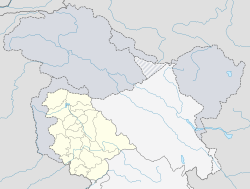Kargil
|
Kargil ཀར་གིལ (མཁར་དཀིལ་ལ།) / کرگل करगिल |
|
|---|---|
| city | |

Kargil
|
|
| Location in Jammu and Kashmir | |
| Coordinates: 34°33′N 76°08′E / 34.550°N 76.133°ECoordinates: 34°33′N 76°08′E / 34.550°N 76.133°E | |
| Country |
|
| State | Jammu and Kashmir |
| District | Kargil |
| Government | |
| • Body | Ladakh Autonomous Hill Development Council - Kargil (LADAKH) |
| Area | |
| • Total | 14,086 km2 (5,439 sq mi) |
| Elevation | 2,676 m (8,780 ft) |
| Population (2011) | |
| • Total | 143,388 |
| • Density | 10/km2 (26/sq mi) |
| Languages | |
| Time zone | IST (UTC+5:30) |
| Vehicle registration | JK07 |
| Website | www |
Kargil is a city in the Kargil district of Ladakh, in the Indian state of Jammu and Kashmir. It is the second largest town in Ladakh after Leh. It is located 60 km and 204 km from Drass and Srinagar to the west respectively, 234 km from Leh to the east, 240 km from Padum to the southeast and 1,047 km from Delhi to the south.
Present-day Kargil was not the natural capital of the region, or Purig as it was also known. Earlier, Purig consisted of a number of small but independent kingdoms, which included Chiktan, Phokhar, Sot and the Suru Valley. These tiny principalities would often fight among themselves over petty issues. Gasho “Thatha Khan”, an exiled prince in the 9th century AD, is perhaps the first ruler who brought together all the territories under a united administration. Another sultan of Purig extended his kingdom to include Zanskar, Pashkum (Jammu and Kashmir) and Sodh, pretty much the territory of the present Kargil district. He is referred to as “the Purig Sultan”. His capital was based at Karpokhar in the Suru Valley. The other famous kings of Kargil were Boti Khan, Abdal Khan, Amrood Choo, Tsering Malik, Kunchok Sherab Stan and Thi Sultan.
It is said that it was the period of Ali Sher Khan Anchan, the famous ruler of Skardu, in the late 16th and early 17th centuries which had a great influence on the area. This prince from Baltistan conquered most of the principalities of Purig and introduced Balti culture in the Kargil district. Subsequently, it was the Dogras who united Baltistan, Purig, Zanskar and present-day Leh district in the first half of the 19th century under a single administrative unit, which lasted till 1947 when a new line of control was demarcated between India and Pakistan separating Skardu and Kargil.
...
Wikipedia


